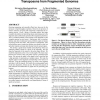5 search results - page 1 / 1 » Joint base-calling of two DNA sequences with factor graphs |
ICASSP
2008
IEEE
13 years 11 months ago
2008
IEEE
—Automated estimation of DNA base-sequences is an important step in genomics and in many other emerging fields in biological and medical sciences. Current automated sequencers p...
BIBM
2008
IEEE
13 years 11 months ago
2008
IEEE
We propose a novel approach for predicting protein functions of an organism by coupling sequence homology and PPI data between two (or more) species with multifunctional Gene Onto...
BMCBI
2005
13 years 4 months ago
2005
Background: Several problems exist with current methods used to align DNA sequences for comparative sequence analysis. Most dynamic programming algorithms assume that conserved se...
EMNLP
2010
13 years 2 months ago
2010
Many sequence labeling tasks in NLP require solving a cascade of segmentation and tagging subtasks, such as Chinese POS tagging, named entity recognition, and so on. Traditional p...
BCB
2010
12 years 12 months ago
2010
Growing sequencing and assembly efforts have been met by the advances in high throughput machines. However, the presence of massive amounts of repeats and transposons complicates ...

